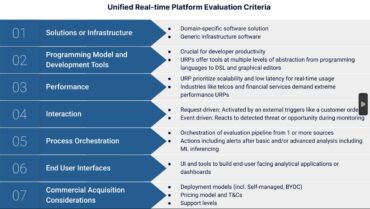
Giving viewers personalized experiences in real-time has become a requirement for any streaming service that wants to stay on top.
Direct-to-consumer (D2C) streamingservices have exploded in the past five years, and most viewers consume media via a subscription-based model. While Netflix showed the promise of the D2C model, and many traditional industry stalwarts like Disney followed suit, the brand also became a cautionary tale to broadcasters spending (and losing) billions of dollars around scaling D2C services and relying solely on subscriber growth.
The next chapter in the streaming wars will highlight brands that keep subscriber numbers strong while mitigating churn, which is even more important in such a turbulent market. A good retention strategy will focus on meeting the viewer where they are with hyper-personalized content, on the right platform, at the right time – decisions based on analyzing customer data.
Leveraging data for retention
To keep viewers on their platforms, streaming services have to be smart about how they collect and use their vast and varied data, what price point they will offer their services, what partnerships to pursue, what content to acquire and for what price, and how to keep customers engaged to increase dwell time.
Data is the most valued resource in every media organization, and most media companies have more data on consumers, advertisers, and their services than any other industry. Although that will change in a cookie-less world, forcing companies to improve upon their first-party data strategy. Consumer data will become even more valuable for companies to share in order to build a complete viewer profile, benefiting both the brand and the user.
However, the main challenge many brands come up against is around building a culture of data. That means ensuring data is democratized and used for competitive advantage while meeting the heightened customer expectation of being known and served with a relevant experience anytime, anywhere, and on any device.
Using this data to determine the primary audience of any streaming platform is key. It’s not about being everything to everyone; it’s about getting the data to deliver quality content to target audiences and meeting them in real time.
See also: How Artificial Intelligence Can Improve Customer Experience
How streaming can remain competitive in the long run
Giving viewers personalized experiences in real-time has become a requirement for any streaming service that wants to stay on top. It’s not enough to only acquire new subscribers; now, streaming service providers have to make their subscribers superfans that stick to their platform of choice.
The primary way streaming companies will stay competitive is to drive relevant, one-on-one experiences around content that matter most to a viewer, established by data analysis. Consumers quickly expect recommendations and a highly-personalized experience as soon as they sign up. Leaders in the space are building competency around providing customers with content recommendations within 30 seconds of new users hitting their platform.
Another strategy to stay competitive is to join forces in this crowded market. Many streaming brands are getting hammered for the billions they are spending (and losing) on content, signaling the importance that content companies place the right bets on acquisition. Recent mergers like MGM and Amazon, Comcast and ViacomCBS, and Warner Bros’ Discovery and HBOMax show the power of collaboration to offer customers a wide range of high-quality content.
Streaming titans are also bundling their services with telecom providers to drive subscription growth. Examples include Verizon offering customers Disney+ and Discovery+ and TMobile providing Netflix. Other brands bundle video with additional services like Apple TV as a bonus to buying Apple products and Amazon Prime Video free with a Prime membership. Other players like Paramount Global’s Pluto TV and Fox Corp’s Tubi are shaking up the market with free, ad-supported streaming services (FAST channels), signaling the many paths to success of a streaming platform.
Bundled and free offerings allow companies alternative revenue sources beyond pure-play subscription platforms and are a great example of how streaming services leverage other avenues to gain subscribers. Still, what these brands do to keep viewers on their platforms will dictate the winners.
See also: Omnichannel Customer Experiences Need Accurate First-Party Data
Take action with data
The top brands will be the ones that wrangle big data in a digestible way for analysts to work with and build a culture around that data. For example, clickstream data is precious for companies to understand what content their customers enjoy most. Analyzing the correct data can dictate what types of content the brand should buy, the content lifecycle of where best to make the content available, and what to recommend the viewer watch next. Furthermore, thorough data analysis will help to harmonize the customer experience across apps and martech stacks.
Art and science are coming together to make decisions on content programming. Top media companies work with self-service data platforms, Customer Data Platforms (CDPs), and Data Management Platforms (DMPs) to build coherent views of customers. By better understanding the customer, decision-makers can bolster a culture of data as a corporate initiative.
Whether driving personalization or determining the right audience to sustain massive costs for content acquisition, moving an organization from gut to data is a journey and one that can enable the following initiatives:
- Personalize content to drive smarter one-on-one experiences at scale
- Monetize services by optimizing advertiser and content company outcomes across channels
- Innovate business to be a data-centered organization where IT agility drives business agility
- Address privacy when collecting data in a cookie-less world
Consumers are becoming less virtuous in paying for a service they barely use, even if it’s low cost. The answer is to perfect the one-on-one experience to produce real-time, quality content.
What’s next for Streaming 2.0?
The streaming wars have officially entered a new phase with some platforms taking a hit, others staying strong, more being added, and still others joining forces. While the bubble perhaps hasn’t burst, what streaming platforms choose to offer customers based on data will determine who comes out and stays on top. Streaming 2.0 will be survival of the fittest, meeting the consumer where they are with content that resonates.





























